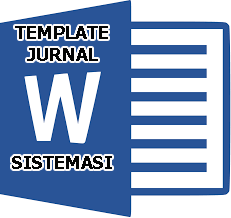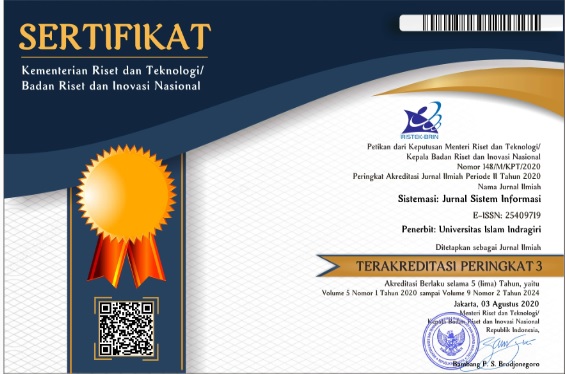Literature Review: A Comparative Study of Waste Classification using Deep Learning Algorithms
Abstract
Keywords
Full Text:
PDFReferences
V. Damayanti, “Laporan Kinerja Direktorat Pengurangan Sampah,” Jakarta, Jan. 2024.
Z. Nugraha Indra, Arnita, K. Saputra, A. Setiawan, R. Maharani, and F. Zaharani, “Implementasi Algoritma CNN dalam Pengembangan Website untuk Klasifikasi Sampah Organik dan Non-Organik,” Jurnal Manamen Informatika & Sistem Informasi, vol. 8, no. 1, pp. 90–101, Jan. 2025, doi: 10.36595/misi.v5i2.
C. Eva Sari Nainggolan, M. Nasir, and D. Udariansyah, “Perbandingan Klasifikasi Jenis Sampah menggunakan Convolutional Neural Network dengan Arsitektur ResNet18 dan ResNet50 the Classification Comparison of Waste Type using Convolutional Neural Network by Resnet18 and Resnet50 Architecture,” vol. 16, no. 1, p. 76, 2024, doi: 10.22303/csrid.1.1.2022.01-10.
Q. A’yuni 1 and B. Hendrik, “Literature Review : Analisis Kompratif Algoritma CNN, KNN, dan SVM untuk Klasifikasi Penyakit Kelapa Sawit,” Journal of Education Research, vol. 5, no. 4, pp. 6589–6596, Dec. 2024, doi: https://doi.org/10.37985/jer.v5i4.1983.
F. Dwiatmoko, D. Utami, N. A. Sivi, U. Nahdlatul, and U. Lampung, “Klasifikasi Citra Sampah Organik dan Non Organik menggunakan Algoritma CNN (Convolutional Neural Network),” 2024.
G. S. Susanth, L. M. J. Livingston, and L. G. X. A. Livingston, “Garbage Waste Segregation using Deep Learning Techniques,” IOP Conf Ser Mater Sci Eng, vol. 1012, no. 1, p. 012040, Jan. 2021, doi: 10.1088/1757-899x/1012/1/012040.
A. Marzuki, A. Zaky, A. C. Adha, and T. M. Yoshandi, “Analisis Model Klasifikasi Sampah Botol berbasis Image Processing dan Machine Learning dalam Rancang Bangun Aplikasi Penukaran Sampah Botol Otomatis,” 2024.
G. A. Bahagia and M. Akbar, “Klasifikasi Sampah Organik dan Anorganik menggunakan Metode Convolutional Neural Network (CNN),” Yogyakarta, Oct. 2024.
A. Aprilla, W. Prihartono, and C. L. Rohmat, “Optimasi Model Klasifikasi Citra Sampah Daur Ulang dengan Algoritma Yolo 11,” Jurnal Khatulistiwa, vol. 12, pp. 92–97, Dec. 2024.
P. Sampah, D. Ulang menggunakan, and S. Helmiyah, “Pengenalan Sampah Daur Ulang menggunakan Machine Learning untuk mendukung Pengelolaan Limbah Berkelanjutan,” Jurnal Pendidikan, vol. 8, no. No.1, pp. 71–78, Feb. 2025.
W. Liu, J. Jiang, N. Li, Y. Wang, K. Liu, and C. Zhao, “A Garbage Intelligent Classification and Recycling System based on Deep Learning,” in Procedia Computer Science, Elsevier B.V., 2024, pp. 744–750. doi: 10.1016/j.procs.2024.09.089.
R. Kurniawan, P. B. Wintoro, Y. Mulyani, and M. Komarudin, “Implementasi Arsitektur Xception pada Model Machine Learning Klasifikasi Sampah Anorganik,” Jurnal Informatika dan Teknik Elektro Terapan, vol. 11, no. 2, Apr. 2023, doi: 10.23960/jitet.v11i2.3034.
S. J. Buchade and S. Bhoite, “Comparative Study of ML Algorithms for Garbage Classification,” Jan. 30, 2024. doi: 10.21203/rs.3.rs-3903806/v1.
Y. Huang, “Research on Garbage Sorting Robotic Arm based on Image Vision,” in Journal of Physics: Conference Series, Institute of Physics, 2024. doi: 10.1088/1742-6596/2741/1/012020.
J. Wang, “Application Research of Image Classification Algorithm based on Deep Learning in Household Garbage Sorting,” Heliyon, vol. 10, no. 9, May 2024, doi: 10.1016/j.heliyon.2024.e29966.
K. Demir and O. Yaman, “Projector Deep Feature Extraction-based Garbage Image Classification Model using Underwater Images,” Multimed Tools Appl, Oct. 2024, doi: 10.1007/s11042-024-18731-w.
B. Fu, S. Li, J. Wei, Q. Li, Q. Wang, and J. Tu, “A Novel Intelligent Garbage Classification System based on Deep Learning and an Embedded Linux System,” IEEE Access, vol. 9, pp. 131134–131146, 2021, doi: 10.1109/ACCESS.2021.3114496.
DOI: https://doi.org/10.32520/stmsi.v14i3.5163
Article Metrics
Abstract view : 641 timesPDF - 124 times
Refbacks
- There are currently no refbacks.

This work is licensed under a Creative Commons Attribution-ShareAlike 4.0 International License.









